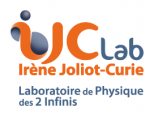Description of research activities
Invested personnels : Laurent AUDOUIN, Laurent TASSANT GOT
Contact : Laurent AUDOUIN
The fragments produced during nuclear fission constitute a remarkable window on this phenomenon and on nuclear structure in general; but they are also of direct interest for the electro-nuclear cycle. Indeed, many observables such as isotopic yields, recoil energy or neutron yields are of direct interest to the nuclear power application since they impact key quantities such as prompt energy, residual heat and core reactivity of a reactor. Many fission measurements therefore fall within the scope of “nuclear data”: they are conducted more for accuracy than to explore new questions, in order to improve the reliability of reactor and fuel modelling.
Outside the region of long-lived nuclei, data are scarce and the measurement of exotic systems is a powerful test to validate fission models and to advance our understanding of this particularly complex phenomenon.
Measurements made at GSI, in the framework of the SOFIA experiments and the R3B collaboration, allow us to study fission yields with an unprecedented precision. Based on inverse kinematics (the system of interest constitutes the beam, its fission is triggered in flight), they offer direct and complete access to isotopic yields (identification in A and Z), and this for a wide range of radioactive nuclei thanks to the production of secondary beams by the FRS fragment separator. IJC Lab is a key player in this collaboration thanks to the provision of 4 wire chambers, used for secondary beam and fragment tracking.
After a demonstration experiment and a measurement dedicated to 236U (analog of 235U+n, the key reaction of the electro-nuclear cycle), a 3rd experiment takes place in 2021, dedicated to the study of the symmetry-asymmetry transition in the highly neutron-deficient Hg-Pb region. These nuclei have recently been the object of strong theoretical developments and important experimental efforts (in particular at ISOLDE) but the results of SOFIA, in quantity as well as in quality, will shed new light on the physics of fission in this region. During this same campaign, the (p,2p) pathway to initiate fission is also studied.
Between 2000 and 2020, the team played a leading role in fission probability measurements at the n-TOF facility at CERN (link : https://ntof-exp.web.cern.ch/), in particular by developing a parallel plate detector system allowing to reach unprecedented measurement accuracies. This program is now closed by strategic decision of IN2P3.
Recent publications
-
Evidence for a New Compact Symmetric Fission Mode in Light Thorium Isotopes, A Chatillon, J Taïeb, H Alvarez-Pol, L Audouin, Y Ayyad, G Bélier,… Physical Review Letters 124 (20), 202502
-
Experimental study of nuclear fission along the thorium isotopic chain: From asymmetric to symmetric fission, A Chatillon, J Taïeb, H Alvarez-Pol, L Audouin, Y Ayyad, G Bélier, … Physical Review C 99 (5), 054628
-
Fission in inverse kinematics, L Audouin, L Grente, A Chatillon, J Taieb, Nuovo Cim. 41, 176
-
Studies on Fission with Aladin; J Taieb, L Grente, A Chatillon, JF Martin, G Belier, G Boutoux, A Ebran, … Fission and Properties of Neutron-Rich Nuclei: Proceedings of the Sixth …
-
Accurate measurements of fission-fragment yields in 234,235,236,238 U (γ, f) with the SOFIA set-up, A Chatillon, J Taïeb, JF Martin, E Pellereau, G Boutoux, T Gorbinet, …
EPJ Web of Conferences 111, 08001 - Fission program at n_TOF, L Tassan-Got, N Colonna, M Diakaki, Z Eleme, A Manna, A Sekhar, … EPJ Web of Conferences 211, 03006





